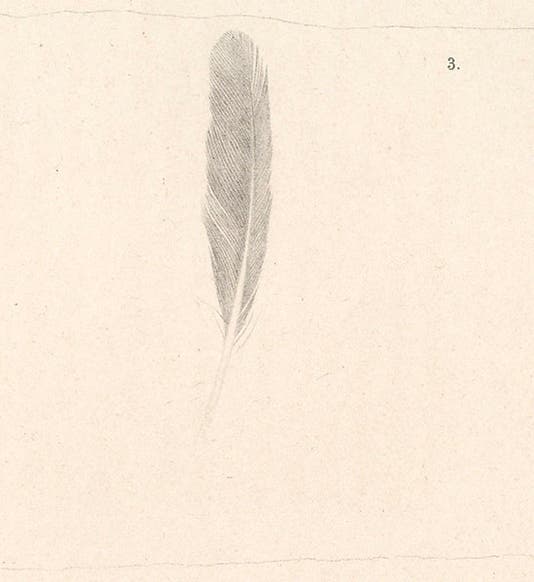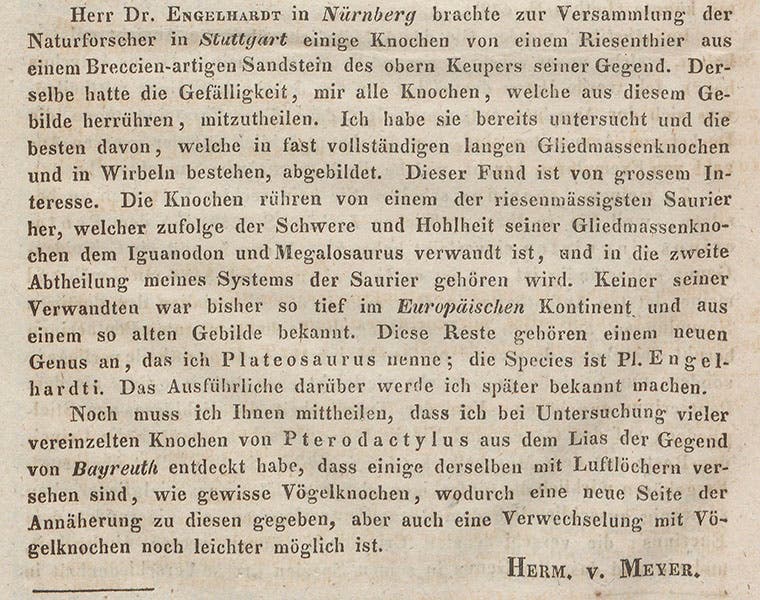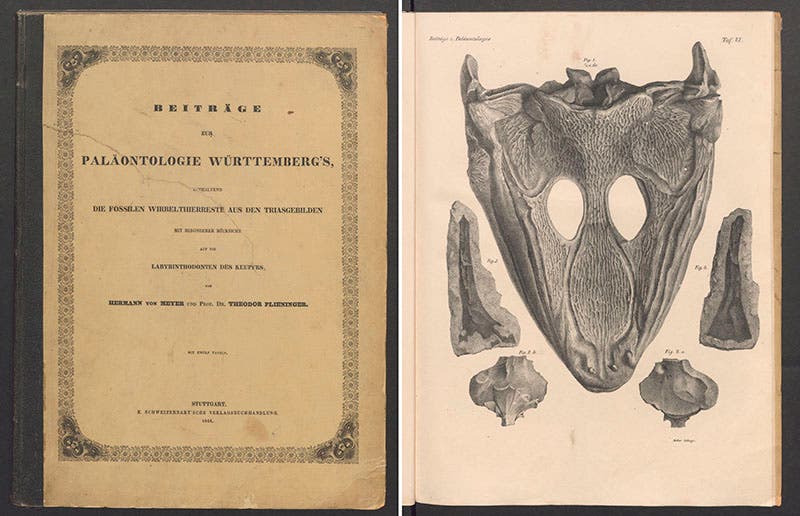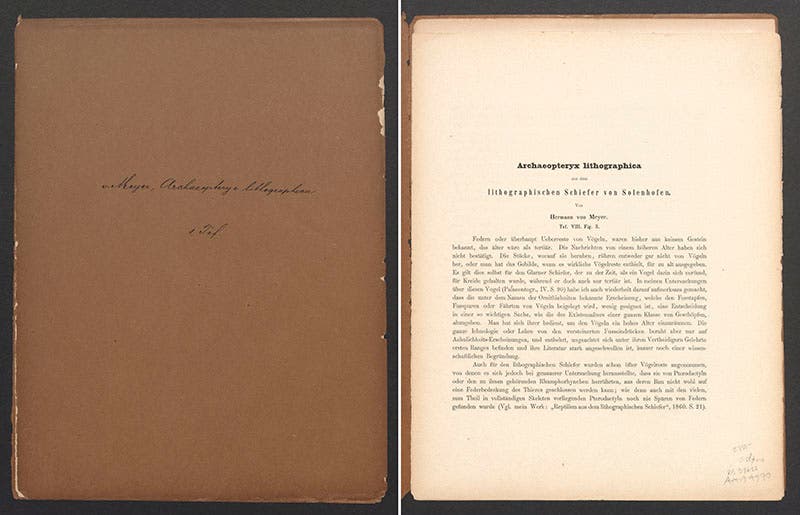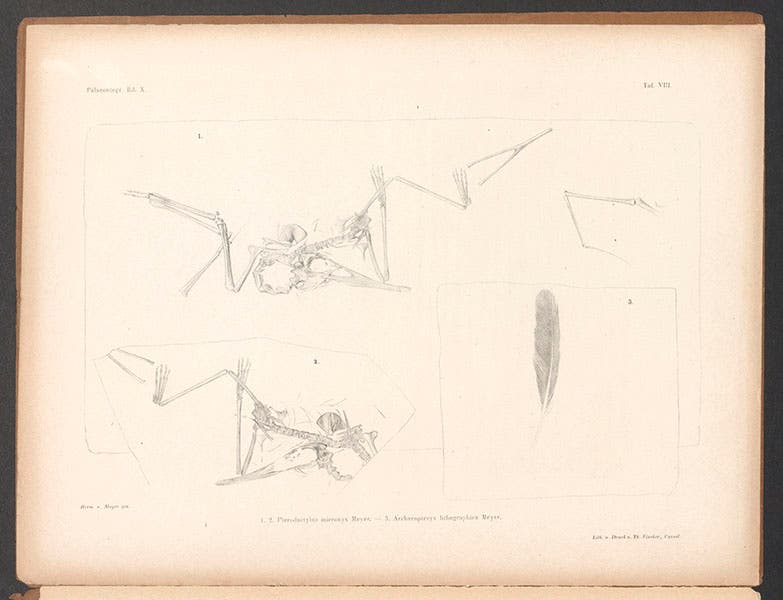Scientist of the Day - Hermann von Meyer
Hermann von Meyer, a German paleontologist, was born Sep. 3, 1801. Most biographies of von Meyer volunteer that he is best known for being the first to describe Plateosaurus, a Triassic dinosaur unearthed by Johann Engelhardt in 1834 and named by von Meyer in 1837. Von Meyer's paper is a short 3-page letter with no images, probably because there were initially very few fossils to go by; we show the last paragraph of the text, where you can make out “das Ich Plataeosaurus nenne” and Meyer’s name at the end. Now, however, Plateosaurus is known by more specimens than nearly any other early dinosaur, so to have been the first to publish it, at a time when only 4 other dinosaurs had been discovered, is we suppose a moderately big deal. You can see a modern Plateosaurus mount here, in a museum in Tubingen.
But one might argue that a more significant publication was von Meyer’s Beiträge zur Paläontologie Wurttemberg’s, an illustrated folio on Triassic reptiles and amphibians, with fine lithographed plates; we acquired our copy in 1994 from Dieter Schierenberg in Amsterdam (third image). Of particular interest are the images of specimens of Mastodonsaurus, Triassic amphibians that loomed rather large before dinosaurs took over; they were also called Labyrinthodons in von Meyer’s time. Up to 15 feet long, they are distinguished by their large triangular-shaped skulls. Von Meyer gives us both top and bottom views of a skull; we show here the top, with its very unusual texture (fourth image). Mastodonsaurus was discovered by Georg Friedrich Jaeger in 1828, but he had only a tooth to work from; we don't know of any depictions of skeletons or skulls before those of von Meyer, although there surely are some. There are many later ones; here is a mounted specimen in Stuttgart.
Von Meyer's greatest discovery, however, was a fossil feather. He found it in 1861 in a slab of lithographic limestone from Solnhofen in Bavaria. The limestone was of Jurassic age and contained large numbers of bones of pterodactyls and other Jurassic reptiles, but none of them had feathers.� Von Meyer's find was by far the oldest specimen of anything resembling a bird. Von Meyer named the species from which the feather came, Archaeopteryx lithographica, the "Ancient wing from the lithographic limestone."
Just as he was about to publish a paper on his discovery, a skeleton was found at the same site; it was missing the head but was otherwise complete, and the long front limbs and the bony tail were surrounded by impressions of feathers. Von Meyer's Archaeopteryx was suddenly on firmer ground.
Much to the consternation of von Meyer and the German community, the owner of the fossil, Karl Häberlein, sold it to the highest bidder, which just happened to be the British Museum of London, and so the fossil of the century went to England. Richard Owen, head of the Natural History branch of the British Museum and the one who had negotiated the sale, could now write the definitive paper on Archaeopteryx, a possible ancestor of modern birds. We displayed Owen's paper, "On the Archaeopteryx of von Meyer," with its life-size lithograph of the specimen, in our exhibition, Paper Dinosaurs.
But von Meyer published his paper well before Owen’s, in 1861, in the journal Palaeontographica, naming the species and reproducing the feather. It was the first mention and image of Archaeopteryx in print. When we mounted our Paper Dinosaurs exhibit, we did not have von Meyer's paper. We have since acquired it, just three pages of text and a plate, from bookseller Jeremy Norman in San Francisco. Two of the images on the plate shows a pterodactyl skeleton from Solnhofen, but one figure depicts the newly discovered Archaeopteryx feather (entire plate, seventh image; detail of feather, first image). We confess we do not know if the fossilized feather survives in some German museum; we certainly hope so, and further hope that someone will inform us of its whereabouts, if it is still with us.
Dr. William B. Ashworth, Jr., Consultant for the History of Science, Linda Hall Library and Associate Professor, Department of History, University of Missouri-Kansas City. Comments or corrections are welcome; please direct to ashworthw@umkc.edu.

